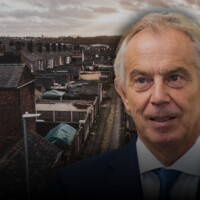In many ways, Donald Trump is an avatar of America. He can own a golden tower bearing his name and still appear perfectly at home working in a McDonald’s drive-through. His ability to embody both the ordinary and the extraordinary has crafted an image of a man deeply entwined with the mythology of the United States. His character, from an Old World perspective, seems to match that of the nation he will soon once again represent. The European eye sees both Trump and Americans more generally as more willing to project an unwavering confidence in both the future and themselves, a willingness to acknowledge one’s own strengths, and an unwavering determination to voice one’s opinion. Some might say: “a perfect match”.
Enjoy independent, ad-free journalism - delivered to your inbox each week
As he prepares for a return to the presidency, Trump’s relationship with America seems less like a candidacy and more like a marriage. Viewed through such a lens, there exists a British folkloric traditional rhyme, originating in the 19th century, that a prospective bride must have a collection of items to guarantee good luck in their future. It is likely that Trump’s mother, when she immigrated to the U.S. in 1930 from the Isle of Lewis in Scotland’s Outer Hebrides, taught him this rhyme that is still synonymous with British marriages to this day.
Something old,
something new,
something borrowed,
something blue,
and a sixpence in her shoe.
This folk rhyme serves as a compelling means in which to view Trump’s 2025 policy agenda. Each element of the rhyme corresponds to a defining aspect of his vision for America:
- Something Old: Trump’s revival of heavy import tariffs. In marriage, The Old is intended to protect the baby to come – the American golden age as Trump calls it.
- Something New: The unprecedented expansion of executive orders. The New, in marriage, represents optimism for the future, which, given the impression of the ineffectual and dishonest role of politicians, Trump’s declaration that he will enact many of his policies on the first day in office restores faith in the American political system, for better or worse.
- Something Borrowed: Many of Trump’s social policies resemble a return or reset to an American culture of the 1990’s, a period remembered fondly by many Americans. A borrowed item is thought to bring good luck and, as such, borrowing from a different era may provide “good luck” to Trump in solving American cultural issues.
- Something Blue: Trump’s willingness to include figures historically associated with the Democratic Party, such as Tulsi Gabbard and Robert F. Kennedy Jr. Traditionally, the colour blue represents purity and fidelity. In Trump’s instance it shows a willingness to sidestep more tribalistic associations to maintain a more pure, unified vision of America.
- A sixpence in her shoe: Finally, the sixpence is thought to bring good fortunes in the future which both encapsulates Trump’s broader agenda and his promise of a brighter future for America.
While this symbolic union between Trump and America seems set for compatibility, cracks are already visible in the foundation. Even before the vows are exchanged, signs of strain suggest challenges that could define the marriage ahead. But first, we explore the policy agenda Trump is bringing to the table.
Something old: Tariffs
Trump has expressed his intention to impose heavy tariffs on imported foreign goods with the aim of protecting domestic industry, safeguarding American jobs, and reducing the federal government’s reliance on taxation. Trump has been transparent about the inspiration for this economic approach, citing his appreciation of William McKinley, the 25th President of the United States, whom he dubbed the “Tariff King” for his extensive use of tariffs. In his previous term, Trump did use tariffs but in a different, more targeted way. Goods such as solar panels, steel, and aluminium were subject to import tariffs, with China being the main exporter affected. Trump’s new large-scale expansion of this policy would see a 60% tariff on goods from China and a tariff of up to 20% on everything else the United States imports. This is quite a drastic measure but may serve as a starting point for negotiations with individual nations, in which Trump intends to broker better deals. These tariffs act as a means of incentivizing an agreement whilst punishing those unwilling to negotiate.
While these measures aim to revitalize domestic industry — an approach that will no doubt be popular within the Rust Belt and among blue-collar workers — they may push up prices for consumers, an especially pressing concern after inflation eroded household purchasing power following the economic damage of the Covid lockdowns. Nevertheless, there are clear, self-evident benefits to facilitating the growth of domestic industries. Not only does the United States become more self-sufficient, which also brings added national security benefits, but it also becomes increasingly competitive in markets previously dominated by other countries — China in particular. The perceived success of these policies will be measured by whether US citizens will be willing to overlook potential short-term price rises for the prospect of better household purchasing power in the future. However, those in protected industries will likely be overwhelming in their support of such policies, representing a good portion of Trump’s base.
Something New: Executive orders
Perhaps the most distinctively novel feature of Donald Trump’s proposed agenda is his stated intention of unprecedentedly expansive use of executive orders as a governing tool. Trump plans to sign approximately 100 executive orders on his first day in office, a strategy that signifies a clear break from presidential convention. Biden, in his first week in office, signed more executive orders than Donald Trump did in almost two months in office, at 17. This move was criticised at the time as a more dictatorial approach to the use of presidential powers and may play into Democratic rhetoric that Trump intends to serve his second term in the White House in a far more dictatorial way. The outlook for Trump is not as bleak as it may appear in this sense, as there is a clear advantage to his use of his presidential powers in this way – that he signals to his base that he is serious about his agenda and wishes to keep his word. There has long been a sense that politicians are “are all talk, no action”, a sentiment in which Trump himself echoed in 2015, and could go a long way towards restoring faith in the political system for better or worse.
Key priorities include border security and immigration enforcement, such as completing the border wall, establishing new detention facilities, and accelerating deportations. Additionally, Trump has pledged to reinstate Schedule F, a federal workforce regulation that would reclassify thousands of civil service employees, giving the executive branch greater control over hiring and firing. The latter of which intends to make good on his promise to “drain the swamp”, meaning weakening the entrenched bureaucracy in Washington, and is a popular move amongst his supporters. In education, Trump plans to implement policies affecting school gender regulations and to promote school choice initiatives, reflecting his broader aim of cultural and institutional change. Similarly, his energy policies aim to dismantle restrictions from previous administrations, prioritizing domestic energy production over environmental constraints that pushed up the cost of energy and fuel for the average American household.
Something borrowed: A return to 90’s culture
Although he does not state explicitly, Trump’s social policies often evoke a nostalgia for the 1990s, a decade remembered by many Americans as a time of relative economic prosperity and cultural cohesion when compared to today. Trump’s rhetoric frequently critiques the rise of “woke” ideologies, which has become ascendant over the past 20 years, with him rightfully framing as a divisive force in contemporary society. Instead, his vision leans toward a return to a colorblind ideal; a society where individual merit and character are prioritized over group identity and where ideology concerning race, gender, and privilege are not forced down the American people’s throats. The period is portrayed as less partisan and less socially contentious and will appeal to those who are disillusioned with so-called “progressive” politics. However, this may well be addressing the symptoms and not the cause of why such ideologies have emerged in the United States in the first place.
To maintain this cohesion, Trump would have to combat the institutions, both governmental and nongovernmental, propagating these ideas, which, even with the best of intentions, would be very difficult to do – even within the office of the presidency and supported by a Republican congress. Trump’s social policies seem more like a ceasefire, rather than a tearing out root and stem, in the “culture war”. If Trump wishes to maintain the kind of American culture he wishes to promote, more drastic action will likely be needed to bring about an end to “woke” culture. His actions will, perhaps, bring about the social conditions in which these ideas may become more taboo that may alleviate some of the worst excesses of these ideas.
Something Blue
Donald Trump’s willingness to appoint figures historically aligned with the Democratic Party signals a deliberate effort to present himself as transcending partisan divides and promote a unified vision for America. His selection of Tulsi Gabbard, a former Democratic congresswoman and 2020 presidential candidate, as Director of National Intelligence highlights this approach. She is a good fit for the position from the perspective of Trump’s base as she has had an antagonistic relationship with the intelligence community claiming that she was placed on a “secret domestic terror watchlist”. Given the antagonistic relationship between the MAGA movement and the intelligence agencies, Trump’s appointment is signalling his allegiance to his base over those that he, rightfully, presents as doing harm to the US by interfering in domestic politics.
Similarly, Trump’s nomination of Robert F. Kennedy Jr. to lead the Department of Health and Human Services (HHS) further exemplifies this strategy. Kennedy, once a Democratic presidential hopeful and later an independent, has become an influential voice on “big pharma”, Covid, and health more generally. His appointment reflects a more bipartisan attempt to “Make America Healthy Again”. The shaking of the perception of Trump as a hyper-partisan divisive figure is essential in repairing the fracturing of American society and increasing partisanship. Its success will be determined by whether Gabbard and Kennedy are effective in their roles. There is a general view amongst Trump’s base that he has assembled an Avengers-style team of big-named talent, in whose results many are excited to see.
Cracks in the Marriage
While the symbolic union between Donald Trump and America appears poised for another chapter, cracks in the foundation of this marriage are already emerging. These fissures may ultimately define not only Trump’s presidency but also the essence of what America is and aspires to be.
One of the most notable developments is the potential softening of Trump’s hardline stances. His alliance with the tech sector, for instance, signals a shift toward a more collaborative relationship with industries he once criticized for overreach and censorship. His U-turn on the curtailing the use of H1B visas, intended, but often abused, to attract “top talent” to the US has been a considerable point of contention between Trump and his own base before he has even assumed office. It has been hypothesised that this was Trump’s attempt at rewarding many in the tech sector for being more willing to support his 2024 campaign. Equally addressing the status of Dreamers — undocumented immigrants brought to the U.S. as children — suggests a change in approach to immigration, recently stating that they would be allowed to stay despite trying to “gut” the programme previously. These moves risk alienating parts of Trump’s base, for whom unwavering positions on immigration and opposition to perceived “elites” are core tenets of support.
After the honeymoon phase of Trump’s second term gives way to the realities of governance, the true test of this renewed marriage will lie in whether the promises made can withstand the pressures of delivering results. He is likely to face both domestic and foreign attempts to sabotage his successes and so he faces an incredible test of political will. Whether this union leads to a period of stability or further fracturing remains to be seen, but one thing is certain: the relationship between Trump and America will determine the essence of what it means to be an American for long into the future.




Comments (0)
Only supporting or founding members can comment on our articles.